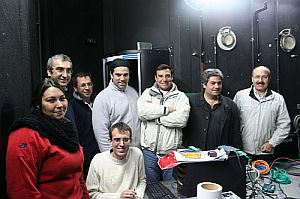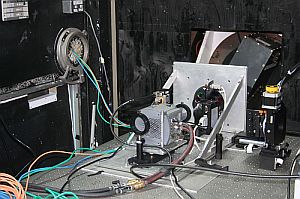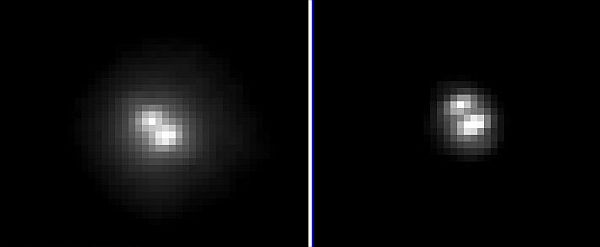FastCam is an imaging camera that takes very short exposures in the optical wavelength range. By selecting the data least affected by the atmospheric turbulence, FastCam can produce
very high-resolution images. The instrument had been tested previously on other telescopes, and on the 27th of november it visited the William Herschel Telescope for the first time.
Basically FastCam camera consists of a detector Andor 512×512 (a low level noise L3 CCD), with optics designed
to provide a pixel scale of 0.019 arcsec, an atmospheric dispersion corrector, and a filter wheel with narrow and broad band filters on.
  |
Left: Part of the commissioning team at the WHT [ JPEG ]. Right: FastCam set up at GHRIL laboratory on the WHT [ JPEG ]. Credit: FastCam commissioning team.
|
Using a FPGA device it is possible to obtain and record series of thousands of
short exposures without interruption, with practically negligible overhead. Specially
designed software
allows direct inspection of the resulting images in real time.
Using exposure times of 30 ms the commissioning team obtained some series of several thousand
images for relatively close visual binaries and under normal seeing conditions.
 |
This figure shows the result of combining the best 5% of a
series of 8000 images obtained for the binary star COU 292 (V=8.4 and 8.7 magnitudes respectively).
Based on available orbital information it was expected an angular separation of 0.07 arcsec for the components.
The binary was resolved in both I (left) and R (right) bands and measured an angular separation of 0.067±0.007 arcsec in the R-band
image. Credit: FastCam commissioning team [ JPEG ].
|
FastCam is a private instrument and it was developed by the Spanish Instituto de Astrofísica de Canarias
(IAC) and the Universidad Politécnica de Cartagena (UPCT).
More information:



